9 B2B Marketing Strategies That Still Work in 2024

Strategy is the foundation of how you market as a business and position your product. It's the "why" behind every action you take as a company. Developing a functional B2B strategy is about understanding what your customers want and how you can best serve them.
It's also about identifying the unique value that your product or service brings to the table.
The trick to any good marketing strategy is ensuring it's sustainable and repeatable. Without standards and processes in place, it's all too easy for your marketing to become a hot mess. That's why companies with documented marketing strategies report 313% more results.
Today, we're going to look at nine B2B marketing strategies that work (almost) every time. We'll also touch on common pitfalls that can trip up even the most well-oiled marketing machine.
But first, let's answer a fundamental question.
Table of contents
- What Is a B2B Marketing Strategy?
- B2B Marketing Strategy vs. B2B Marketing Plan: What is the Difference?
- What Are the Top B2B Marketing Strategies?
- B2B Marketing Strategy #1: Inbound Marketing
- B2B Marketing Strategy #2: Outbound Marketing
- B2B Marketing Strategy #3: Account-Based Marketing
- B2B Marketing Strategy #4: Product-Led Growth
- B2B Marketing Strategy #5: Guerrilla Marketing
- B2B Marketing Strategy #6: Blue Oceans Strategy
- B2B Marketing Strategy #7: Event Marketing
- B2B Marketing Strategy #8: Joint Ventures (With a Twist)
- B2B Marketing Strategy #9: Affiliate Marketing
- Include Reditus as Part of Your B2B Marketing Strategies and Grow Your B2B Company
- Ready to Grow Your B2B SaaS Company with Reditus Leading Your B2B Marketing Strategies?
What Is a B2B Marketing Strategy?
A B2B marketing strategy is a plan for how you will market your product or service to other businesses. This can include everything from your brand positioning to the specific marketing channels you will use.
Some other crucial elements of a B2B marketing strategy might include:
- Target audience: A detailed description of the businesses you want to target with your marketing.
- Unique selling proposition: What makes your product or service different from everything else on the market.
- Key marketing messages: The core messages you want to communicate about your product in your marketing.
- Sales funnel: A step-by-step plan for how you will take a potential customer from awareness to purchase.
- Marketing budget: How much you plan to spend on marketing each month or year.
Build your B2B marketing strategy on a foundation of market research and customer insights. Doing so will ensure that your strategy aligns with your target market and that you solve a real problem for your customers.
By 2026, 65% of companies will rely solely on data for making marketing decisions.
Once you have a solid understanding of your market and your customers, you can put that strategy down on paper.
A documented marketing strategy will help you stay focused and aligned with your goals. It will also make it easier to measure your results and course-correct when necessary.
B2B Marketing Strategy vs. B2B Marketing Plan: What is the Difference?
A marketing strategy is the "why" behind your marketing efforts. It's the foundation that everything else is built on.
On the other hand, a marketing plan is the "how." It's a road map that details the steps you will take to achieve your marketing goals.
Your marketing strategy should be the guiding force behind your marketing plan. Every action you take, and every dollar you spend should be in service of your strategy.
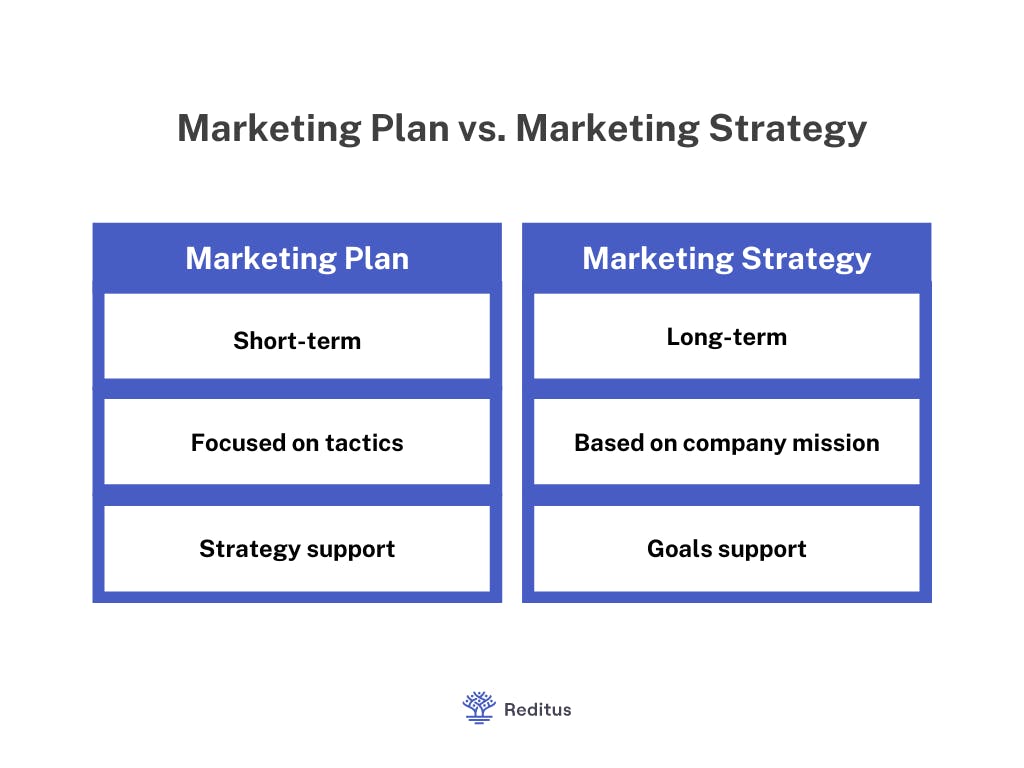
For example, let's say that your marketing strategy is to increase B2B brand awareness.
A crucial part of your marketing plan might be to launch a social media marketing campaign. But that campaign should be designed to drive awareness by reaching a new audience with your message.
If you find that your marketing efforts are not aligning with your strategy, it's time to go back to the drawing board.
What Are the Top B2B Marketing Strategies?
B2B is a bit like a chess game. It's all about making strategic moves that set you up for success down the line.
There is no "one size fits all" solution for B2B marketing. The best strategy for your business will depend on several factors, including your industry, target market, and resources.
That being said, a few B2B marketing strategies have proven to be adequate time and time again. Let's look at nine of the most popular B2B marketing strategies and how you can make them work for your business.
B2B Marketing Strategy #1: Inbound Marketing
An inbound marketing strategy encompasses all your marketing efforts designed to bring customers in rather than going out to them.
Inbound marketing is based on attracting prospects with valuable content and then nurturing those relationships to convert them into customers.
Some common inbound marketing tactics include:
- Content marketing: Creating blog posts, ebooks, and other forms of content designed to educate prospects about your product or service.
- SEO: Optimizing your website and content to rank higher in search engine results pages.
- Social media marketing: Posting engaging content on social media platforms like LinkedIn, Twitter, and Facebook.
- Email marketing: Sending targeted email campaigns to prospects who have signed up for your newsletter or other communications.
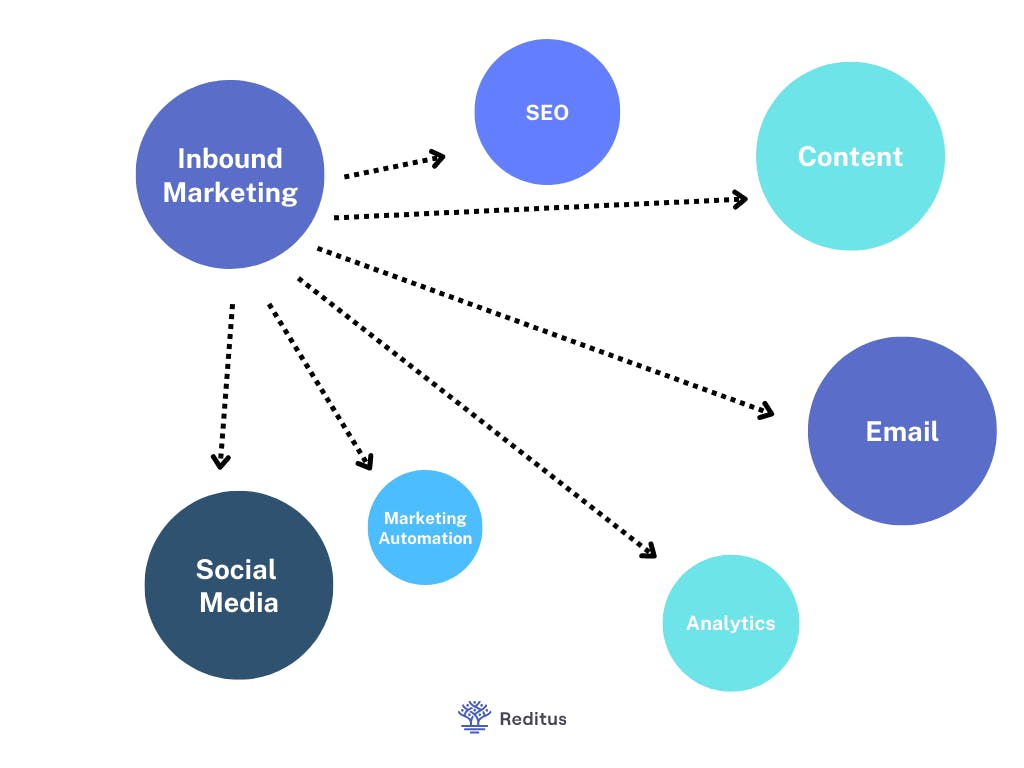
To accurately design an inbound marketing strategy, you'll need to clearly understand your "buyer personas" — a fancy term for your target customer.
Your buyer persona should include information like:
- Demographics: Age, location, gender, and job title
- Pain points: The challenges and problems they are facing that your product or service can help with
- Content preferences: The type of content they prefer to consume (e.g., blog posts, infographics, and videos)
- Jobs to be done: The specific tasks they are trying to accomplish with your product or service
With a solid understanding of your buyer persona (or personas), you can create content that appeals directly to their needs and pain points. The marketing channel you use to distribute that content will depend on where your buyer persona hangs out online.
For example, suppose they are active on LinkedIn. In that case, you might want to focus on creating informative blog posts and sharing them on that platform.
From there, you can use LinkedIn's newsletter features to nurture those relationships and convert them into customers.
Of course, inbound marketing is just one piece of the puzzle. You'll also need to focus on generating quality leads and converting those leads into customers.
B2B Marketing Strategy #2: Outbound Marketing
Outbound marketing is the opposite of inbound marketing. Rather than waiting for customers to come to you, you go out and find them.
Outbound marketing tactics include:
- Paid advertising: Investing in paid search ads, display ads, and social media ads.
- Cold outreach: Reaching out to prospects via email or social media to start a conversation.
- Tradeshow marketing: Attending and exhibiting at trade shows and other events.
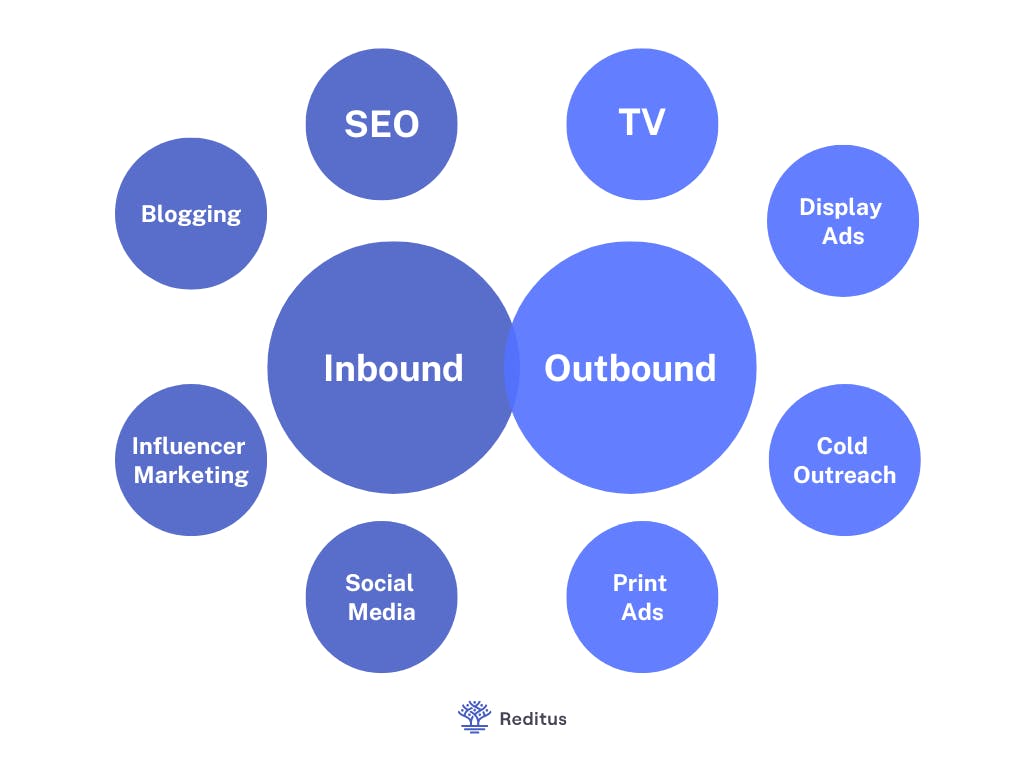
The core principle of outbound marketing is interruption. You are interrupting your target market with your message rather than waiting for them to come across it organically. This doesn't mean outbound marketing is ineffective — it can be a great way to reach new prospects.
The trick is to use outbound marketing tactics judiciously and supplement them with inbound marketing tactics that will help you build relationships with those prospects over time.
For example, you might use a paid search campaign for demand generation. Then use email marketing and social media outreach to nurture those leads and convert them into customers.
B2B Marketing Strategy #3: Account-Based Marketing
Account-based marketing (ABM) is a strategic approach that focuses on key accounts rather than targeting a larger, more generalized audience.
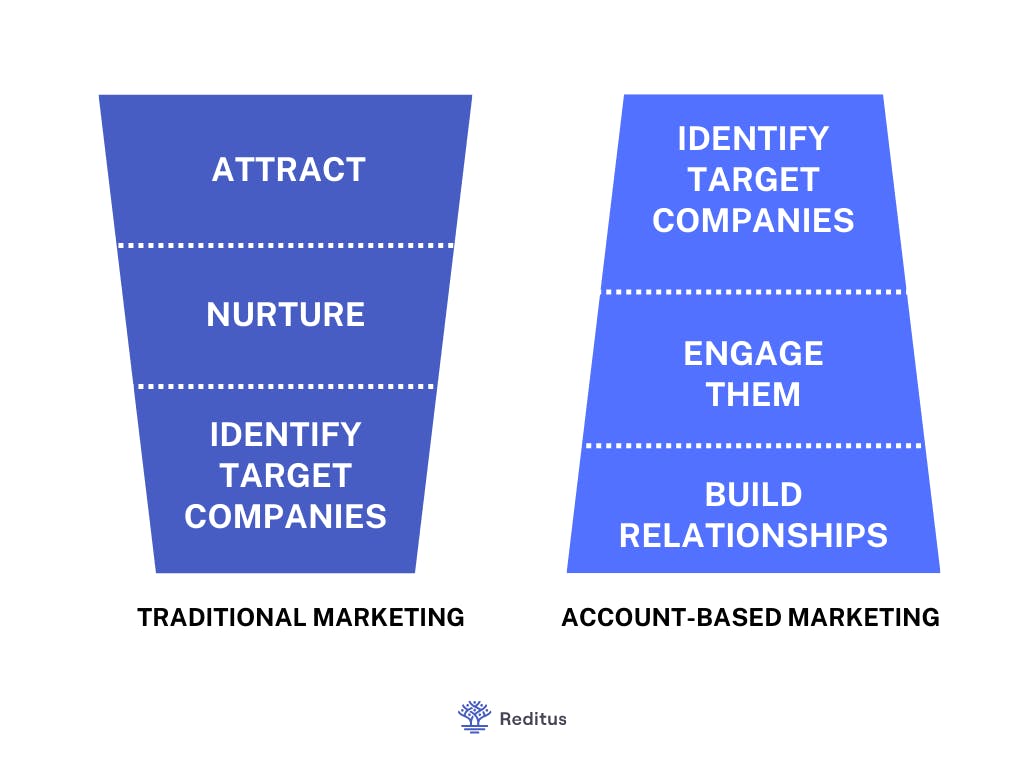
With ABM, you identify and target companies that are more likely to convert, then tailor your marketing messages and strategies to appeal to those specific decision-makers.
ABM requires a lot of research and planning. However, it can be extremely effective for growing your SaaS company, especially if you're targeting larger enterprises.
Let's emphasize that point through an example:
Company A vs. B
Two companies (A and B) compete in the ERP software market. They develop and sell software that helps businesses manage their inventory, finances, and supply chains. It's a complex product that requires a long sales cycle and a high degree of customization.
Company A builds a list of 10,000 potential customers and sends generic mass emails to all of them, hoping that a few will respond.
Company B takes an ABM approach and targets a specific list of companies in their ideal customer profile.
They create targeted content and ads specifically for those companies. They also reach out to specific decision-makers within those companies (such as the CIO or CFO) to try and get them to take a free trial of the software.
Even though Company B targets a smaller list of companies, they're more likely to get their software in front of the right people.
This targeted approach is much more effective than the spray-and-pray method that Company A is using.
Roughly 9 out of 10 marketers say ABM is their top-performing marketing activity. By taking a targeted approach with ABM, you can see similar results for your SaaS company.
B2B Marketing Strategy #4: Product-Led Growth
A Product-Led Growth (PLG) strategy bridges inbound and outbound marketing.
With PLG, your product is the primary vehicle for acquiring and retaining customers. Your marketing efforts are focused on driving awareness and adoption of your product rather than just generating leads.
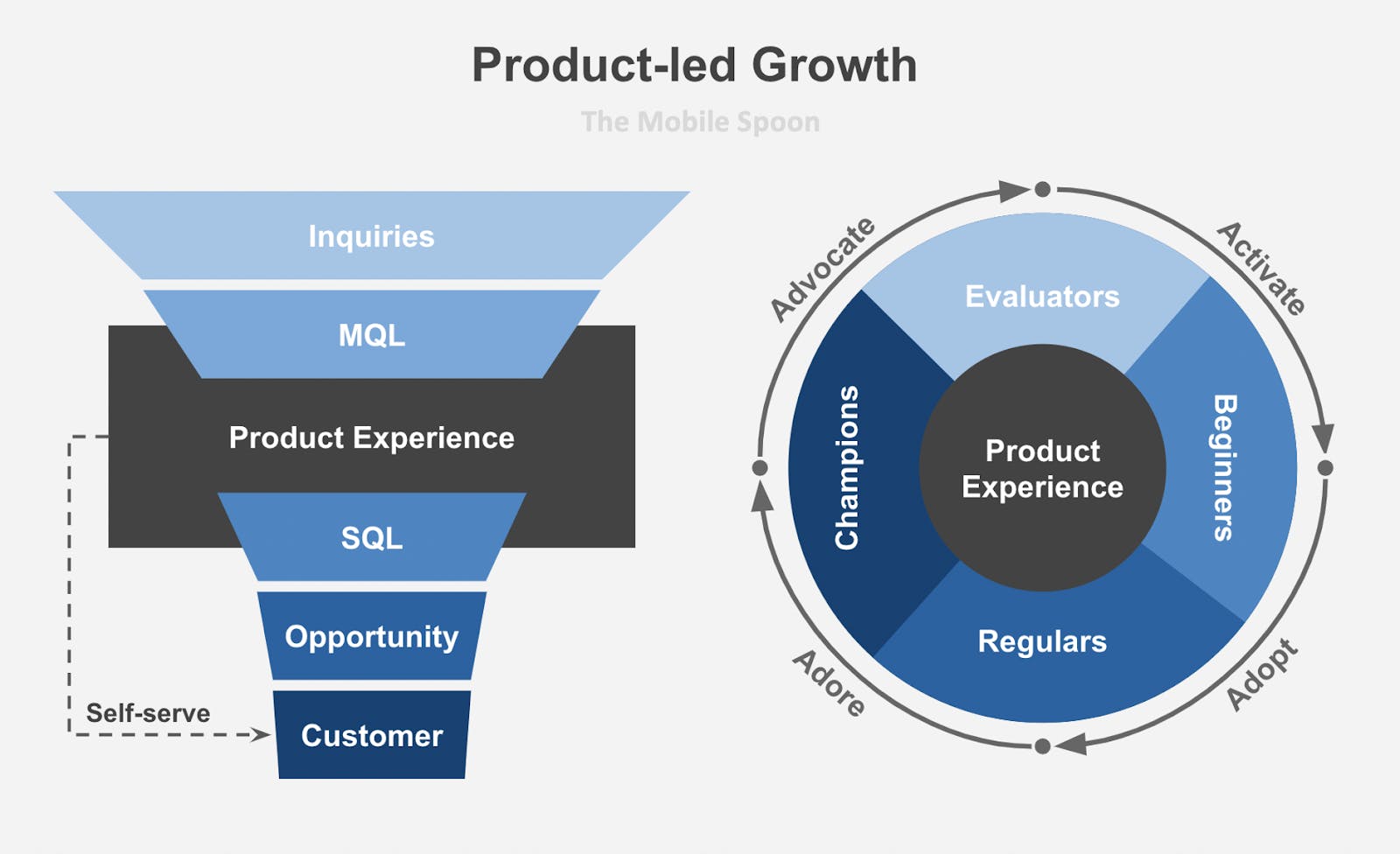
PLG is a common strategy for SaaS companies and is particularly effective for companies with a freemium business model.
Dropbox, Slack, and Trello are examples of companies that have used PLG to grow their businesses.
To implement a PLG strategy, you need a product that is easy to use and provides value to your customers. You also need a robust onboarding process that helps new users get the most out of your product.
"Quick wins" are the hearth of the PLG strategy.
Identify the key outcomes your customers need to accomplish and design your product and onboarding process around those tasks.
For example, imagine that your product helps businesses manage their social media accounts more effectively.
What outcomes do your customers want to achieve?
Some examples might be:
- Generating more leads from social media
- Scheduling a month's worth of social media content in one day
- Increasing engagement rates on their posts
If your product is designed to help your customers achieve these quick wins, they're more likely to keep using it (and paying for it).
More importantly, they're more likely to tell other people about your product.
Product-led growth is about acquiring and retaining customers through your product rather than your marketing efforts. By focusing on quick wins, you can increase adoption and encourage word-of-mouth marketing for your SaaS.
B2B Marketing Strategy #5: Guerrilla Marketing
Guerrilla marketing is a low-cost, high-impact marketing strategy that helps you get noticed. It's the opposite of traditional marketing, which is expensive and time-consuming.
With guerrilla marketing, you need to be creative and think outside the box. The goal is to get people talking about your product without spending much money.
Common guerrilla marketing tactics include:
- Stickers
- Flyers
- Posters
- Word-of-mouth marketing
- PR stunts

One of the most famous examples of guerrilla marketing was when Dollar Shave Club set up a booth outside a Gillette factory and handed out free razors to workers. This generated a lot of buzz for the company and helped them acquire new customers.
Guerrilla marketing might sound like a risky proposition. However, it can be a highly effective way to grow your SaaS company. Even though it's hardly replicable or scalable, it will get people talking about your product.
Think of it as a way to get your foot in the door with potential customers.
Once you've caught their attention, you can use other marketing strategies (like inbound marketing) to close the deal.
B2B Marketing Strategy #6: Blue Oceans Strategy
The Blue Oceans Strategy is about finding untapped markets and creating new demand. Instead of competing in a crowded market, you want to find a "blue ocean" where there is little or no competition.
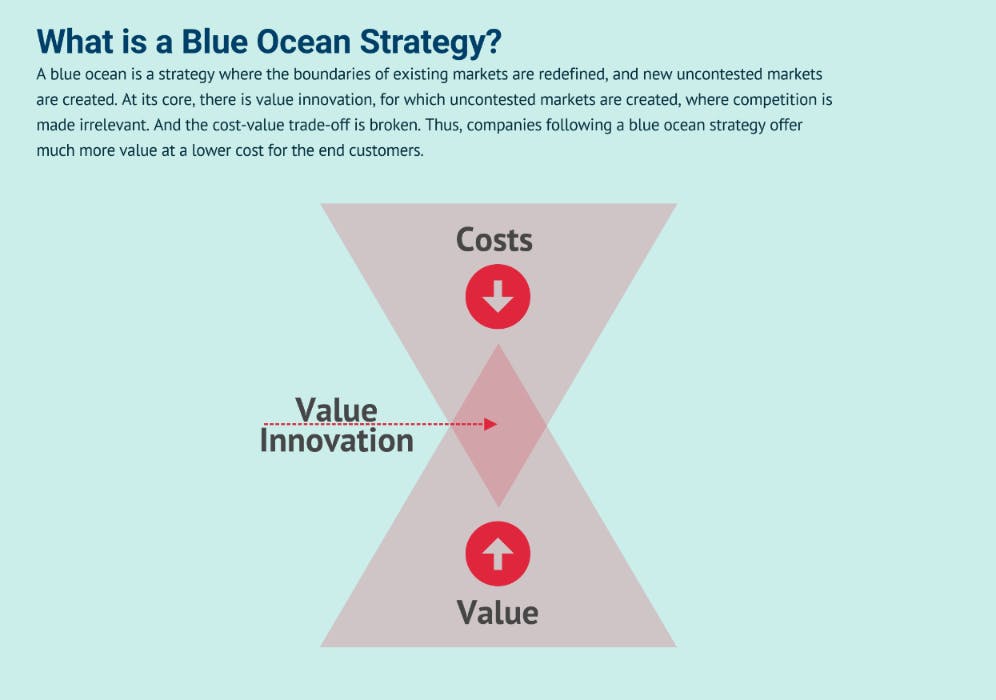
Value innovation — the simultaneous pursuit of differentiation and low cost — is the key to creating blue oceans.
Blue Oceans Strategy isn't a marketing strategy per se, but it can significantly impact your marketing efforts.
By understanding what your competitors are doing and where they're falling short, you can position your product in a way that resonates with customers.
Salesforce is an excellent example of a company that used the Blue Oceans Strategy to grow its business.
When Salesforce launched in 1999, the CRM market was already crowded with big players like Siebel and Oracle.
Instead of competing head-to-head with these companies, Salesforce positioned itself as a "no-software" solution, targeting the neglected small and medium business market.
This strategy helped Salesforce snowball and become the dominant player in the CRM market.
To successfully implement Blue Oceans Strategy, focus on noncustomers and desegmentation. That is, look for people who don't use your product (or a similar product) and find out why.
You can then adjust your product and marketing efforts to address these needs.
You can also study alternative industries to see how they do things and look for ways to apply these concepts to your industry.
For example, Southwest Airlines took inspiration from the hotel industry when they created their boarding process.
By understanding the needs of your noncustomers and looking for inspiration from other industries, you can create a unique value proposition that will help you stand out from the competition.
B2B Marketing Strategy #7: Event Marketing
Event marketing combines in-person and online marketing, using events to promote your product or service.
Events don't necessarily have to be physical — they can also be virtual events, like webinars or online courses.
Event marketing aims to create an interactive experience that will build relationships with potential customers and make a long-lasting impression.
MarketMuse's Content Strategy Collective Conference is an excellent example of event marketing done right.
MarketMuse brings together some of the biggest names in B2B digital marketing each year for a two-day conference.
Attendees get to hear from industry leaders, network with their peers, and learn actionable strategies that they can use to improve their B2B content marketing efforts.
Salesforce, Social Media Examiner, and HubSpot are just a few companies that have benefitted from event marketing.
These companies have built relationships with potential customers by hosting their events.
If you're thinking of hosting an event, consider the following:
- Budget: Events can be costly, so you need to ensure that you have the budget to cover all expenses.
- Location: The location of your event will play a significant role in its success. Choose a location that is easily accessible and has enough space to accommodate your attendees. If virtual, be tech-savvy and have a system to avoid any last-minute surprises.
- Format: Will your event be a one-day conference, a multi-day workshop, or something else? The structure of your event should be based on your goals and the needs of your attendees.
- Marketing: You need to market your event to ensure that people show up. Utilize your channels, from social media to email marketing to word-of-mouth.
When done right, event marketing will position your brand as a thought leader, help you build relationships with potential customers, and build an evergreen marketing asset (e.g., video recordings and blog posts).
B2B Marketing Strategy #8: Joint Ventures (With a Twist)
Traditionally, joint ventures (JVs) are formed between two companies that have complementary products or services.
For example, a JV between a web design company and an SEO agency could offer customers a discount if they sign up for both services.
JVs can be a great way to grow your business, but they can also be time-consuming and challenging to set up.
There's a new twist on the traditional JV that's particularly well suited to SaaS companies. Instead of partnering on the product level, SaaS companies can partner on the marketing level.
In other words, they can cooperate on lead generation and customer acquisition efforts.
This type of JV is often referred to as a "referral partnership."
A referral partnership is an agreement between two companies to refer business to each other.
For example, a SaaS company that provides project management software could partner with an agency specializing in project management consulting.
The consulting agency would refer its clients to the software company. In return, the software company would either pay a commission or give the agency a discount on its products.
Referral partnerships are an effective way to grow your SaaS company because they provide a steady stream of high-quality leads.
They're also relatively easy to set up and manage, making them a low-cost growth strategy.
With a solid partner management system, you can track the leads that come in from your referral partners and measure the results of your partnership. You can also automate the process of paying commissions, which will save you time and money.
With Reditus, for example, you can manage your referral program in a central workspace, making it easy to keep track of your partnerships and see how they're performing.
You can even automate the process of sending commission payments to your partners, making it easy to keep them happy and motivated.
Reditus provides a simple, effective way to manage your referral
partnerships and grow your SaaS company.
B2B Marketing Strategy #9: Affiliate Marketing
An affiliate marketing strategy is similar to a referral partnership, but there are a few key differences. With affiliate marketing, your relationship with your partners is typically much more hands-off.
Affiliate marketing also tends to be more transactional in nature. In other words, it's less about developing a personal relationship and more about driving sales.
That's not to say that affiliate marketing relationships aren't mutually beneficial. However, they typically don't involve the same level of communication and collaboration as a referral partnership.
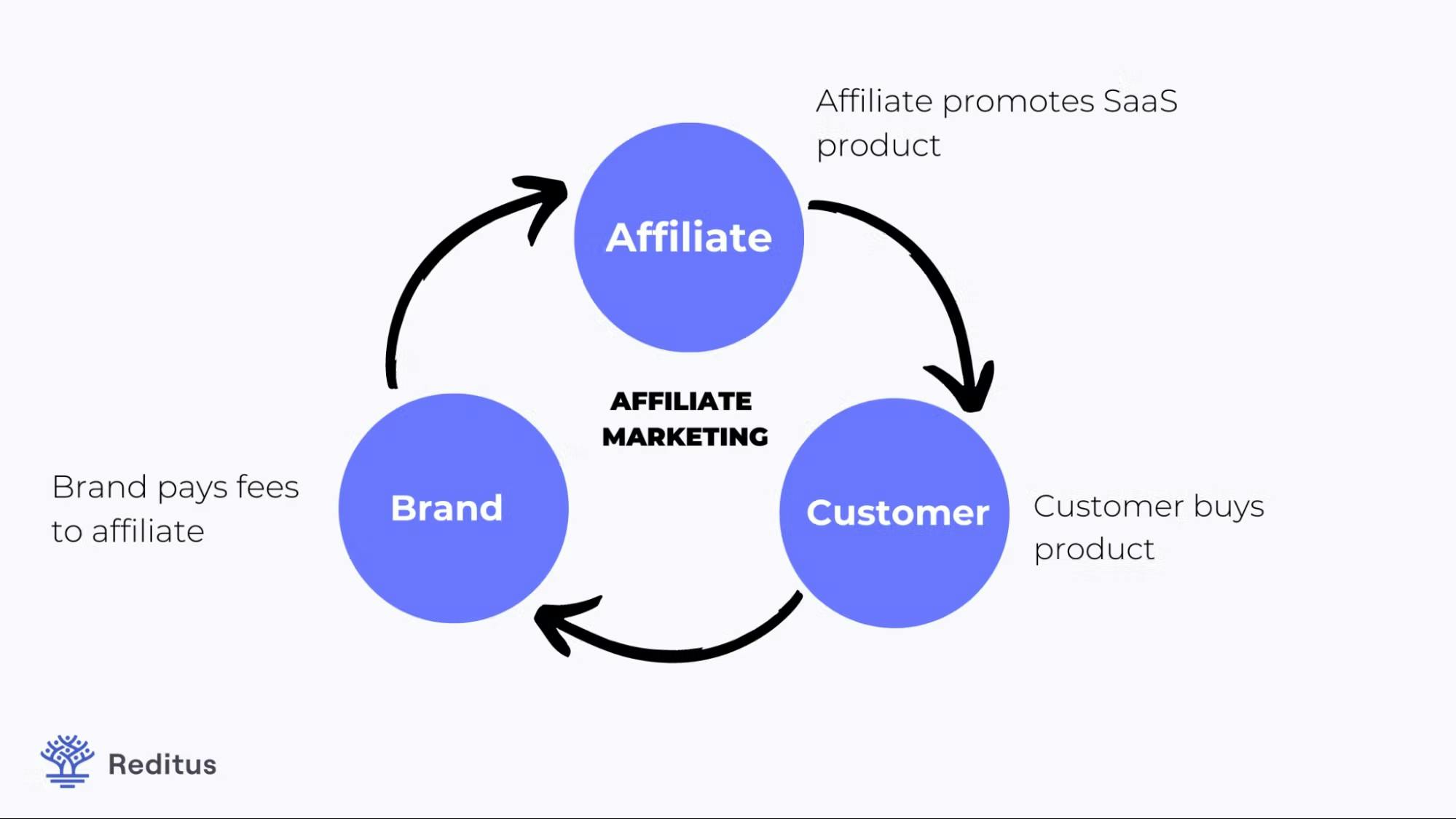
Affiliate marketing is also a performance-based marketing strategy, meaning you only pay your affiliates when they generate results. This is one of the reasons 81% of companies use affiliate marketing to acquire new customers.
This makes it a cost-effective strategy for growing your SaaS company, as you only pay for results.
To set up an affiliate program, you'll need to find affiliates (partners) who are willing to promote your products or services.
You can find potential affiliates in several places, including online directories, forums, and social media groups. Some other ideas might include:
- Paid media: You can use paid advertising to reach potential affiliates who might not be active in online communities.
- Conferences and events: Look for opportunities to meet potential affiliates in person at meetings and events related to your industry.
- Affiliate marketplaces: Several online platforms connect businesses with affiliates making it easy to find quality partners.
The key to success with affiliate marketing is to find the right affiliates. Look for partners who have an audience that's relevant to your business and who are likely to generate high-quality leads.
Also, consider their level of influence and whether they have a positive reputation in the industry.
Setting clear expectations with your affiliates from the start is also important. Be sure to define what constitutes a successful lead or sale and how and when you will pay your affiliates.
This will help to avoid any misunderstandings down the road.
An affiliate management system is essential to running a successful affiliate marketing program.
With Reditus, you can manage your entire affiliate program from one central location. This includes tracking leads and sales and collecting payments and commissions.
This way, you don't have to worry about complex spreadsheets or missed payments.
B2B Marketing FAQs
What are the four types of B2B marketing?
B2B markets, or business-to-business markets, are divided into four categories:
- Intermediary markets involve a third-party broker or mediator.
- Reseller markets involve companies buying goods from a manufacturer to resell them for a profit.
- Institutional markets involve selling goods and services to organizations such as schools, hospitals, and government agencies.
- International markets involve the sale of goods and services between companies in different countries.
What are the 7 stages in the B2B buying process?
The 7 stages in the B2B buying process are as follows:
- Identification of need: A business identifies a need for a product or service.
- Research: The company researches potential solutions to their need.
- Selection of vendors: The business identifies and evaluates potential vendors to meet their needs.
- Negotiation: The firm negotiates price and other terms with the vendor.
- Order placement: The company places an order with the vendor.
- Fulfillment: The vendor fulfills the order, delivering the product or service.
- Evaluation: The company evaluates the vendor's performance and the product or service.
What are the three types of B2B segments?
The three types of B2B segments in SaaS are:
- Enterprise Software: Software designed to meet the needs of large organizations.
- Mid-Market Software: Software designed to meet the needs of medium-sized businesses.
- SMB Software: Software designed to meet the needs of small businesses.
What is the difference between b2b and b2c marketing?
The main difference between B2B and B2C marketing is the targeted customer type.
B2B marketing targets businesses and other organizations, while B2C marketing targets individual consumers. B2B marketing is typically more complex as it involves building relationships and understanding the needs of the business.
Additionally, B2B marketing often involves longer sales cycles due to the complexity of the decision-making process. B2C marketing, on the other hand, typically involves shorter sales cycles and more simplistic decision-making.
What are the main characteristics of b2b marketing?
The main characteristics of B2B marketing include:
- A clear understanding of the customer: B2B marketing requires an in-depth knowledge of the customer's needs. This includes understanding the customer's industry, their financial situation, and the decision-makers in their organization.
- A strong focus on relationships: B2B marketing relies heavily on building relationships with potential customers. This includes developing trust and loyalty and providing helpful advice and product recommendations.
- A long sales cycle: Compared to B2C marketing, B2B marketing typically involves a longer sales cycle. This means that B2B marketers must be patient and focus on providing customers with the information they need to make an informed decision.
- Understanding the customer's budget: B2B marketers must also understand their customer's budgets to create an effective marketing strategy. This includes understanding the customer's current financial situation, as well as their future growth plans.
- An emphasis on ROI: B2B marketers must also focus on delivering a return on investment (ROI). This involves understanding the customer's goals and objectives and creating a strategy that will help the customer meet those goals.
Include Reditus as Part of Your B2B Marketing Strategies and Grow Your B2B Company
Reditus helps you create a new revenue channel through our simple, effective referral and affiliate marketing solutions.
By partnering with other businesses, you can quickly and easily grow your customer base without spending much money on marketing.
We've already covered a few ways to use Reditus to grow your B2B company. Let's take a closer look at how our platform works.
What is Reditus?
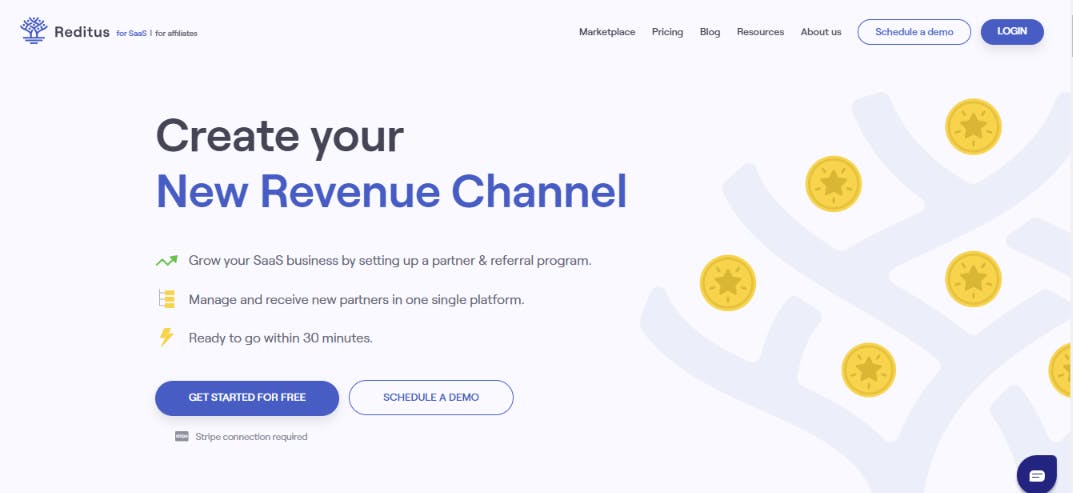
Reditus is a referral and affiliate marketing platform that helps businesses quickly and easily grow their customer base.
We provide a simple, effective solution for SaaS companies looking to tap into new markets and increase their revenue.
How does it work?
No matter your industry, you probably have a few customers who love your product or service.
With Reditus, you can turn those customers into marketing partners by offering them a commission for every new customer they bring in.
Reditus provides you with all the tools you need to start, grow, and manage a partner or affiliate program in one place.
Our platform is simple, friendly, and easy to use. In fact, you can be up and running in 30 minutes or less.
When you create a Reditus account, you get access to an exclusive affiliate marketplace where you can find high-quality leads and sales partners.
We also provide you with a complete suite of tools to track your leads and sales, including:
- Partner management: Keep track of your partners and their performance with our partner management tools.
- Lead tracking: Get real-time insights into which of your marketing campaigns are generating leads.
- Sales tracking: See which of your partners are driving sales and how much revenue they generate.
- Payouts: Pay your partners quickly and easily with our automated payout system.
- Security: We use the latest security technologies to keep your data safe and secure.
To get a more complete overview of how Reditus can help you grow your SaaS business, please schedule a free demo.
Ready to Grow Your B2B SaaS Company with Reditus Leading Your B2B Marketing Strategies?
Every digital marketing strategy should be unique, as it needs to be tailored to the products or services being offered.
However, some general tips can help any SaaS company succeed with their B2B marketing efforts.
First and foremost, focus on developing a solid relationship with your customers. This will help you retain them and encourage them to act as advocates for your business.
In addition, consider using affiliate and referral marketing programs to quickly and easily grow your customer base.
Finally, make sure you use the latest technology to manage your marketing campaigns and track your results. Reditus can help you with all of these things and more.
Contact us today to schedule a free demo if you're ready to take your B2B marketing to the next level. Or, if you’re ready to start, create a free Reditus account.

